Unraveling the threads of a brand story
that's changing the face of business
The Power of a Story: Patagonia’s Strategic Narrative
In the realm of business, where profits often reign supreme, Patagonia stands out as a beacon of a different kind. This iconic outdoor apparel company didn’t simply want to sell products; it sought to redefine the very notion of corporate responsibility. Patagonia’s mission is not just about making clothes; it’s about saving the planet.
Today, we’ll delve into the art of storytelling in business, examining how Patagonia has masterfully crafted its strategic narrative. Think of it as the bedtime story your parents told you, but on a global scale. Let’s unravel the secrets behind Patagonia’s compelling tale.
What’s a Strategic Narrative Anyway?
Before we dive into Patagonia’s inspiring story, let’s explore the concept of a strategic narrative. Imagine your favorite video game. It’s likely not just about point-scoring; it has a compelling narrative – a story that drives you forward, keeps you invested, and makes you want to see what happens next.
Companies can achieve a similar effect through strategic narratives. These are not just sales pitches; they’re grand stories that capture the essence of a company – who they are, what they believe in, and the impact they strive to make on the world. It’s about connecting with customers on an emotional level, inspiring them to join the company’s mission, and move beyond a mere transactional relationship.
Patagonia’s Big Idea: Saving the Planet One Jacket at a Time
Now, let’s look at Patagonia’s story. Their big idea is pretty simple: they want to make great outdoor gear while also taking care of the planet. It’s like if you decided to clean up your room and the whole neighborhood at the same time!Patagonia’s founder, Yvon Chouinard, once said (quoting the conservationist David Brower), “There is no business to be done on a dead planet.” That’s a fancy way of saying that if we don’t take care of Earth, we won’t have anywhere to do business – or play outside!This idea is at the heart of everything Patagonia does. It’s not just something they say to sound nice. It’s something they really believe in and act on every day.
How Patagonia Tells Its Story
Patagonia doesn’t just talk about saving the planet. They show it in everything they do. Let’s look at some ways they tell their story:
- They’re honest about their mistakes: Patagonia doesn’t pretend to be perfect. They admit when they mess up and talk about how they’re trying to do better. It’s like when you tell your parents you broke a vase, but also explain how you’re going to be more careful next time.
- They share customer stories: Patagonia loves to show off what their customers are doing. They share stories and pictures of people having adventures while wearing Patagonia gear. It’s like when you show your friends a cool trick you learned – it makes them want to try it too!
- They ask people to buy less: This might sound weird, but Patagonia sometimes tells people NOT to buy their stuff! They have a program called “Worn Wear” where they fix old Patagonia clothes instead of selling new ones. It’s like when you fix your favorite toy instead of getting a new one.
- They take action: Patagonia doesn’t just talk about helping the planet. They actually do it! They give money to environmental groups and even sue the government sometimes to protect nature. It’s like if you didn’t just say you wanted to help clean up a park, but actually went out and did it.
Why Patagonia’s Story Works
Patagonia’s story works really well for a few reasons:
- It’s real: Patagonia doesn’t just say they care about the planet. They show it in everything they do. People can tell when a company is being honest, and they like it.
- It’s exciting: Patagonia’s story is about adventure and saving the world. That’s way more exciting than just selling clothes!
- It makes people feel good: When you buy something from Patagonia, you feel like you’re helping to save the planet. That feels good, doesn’t it?
- It’s consistent: Patagonia tells the same story all the time, in everything they do. It’s like when you have a best friend who’s always there for you – you know what to expect.
How Patagonia’s Story is Different
Patagonia’s story is pretty different from what other companies do. Let’s look at how:
- Purpose comes first: For many companies, making money is the most important thing. For Patagonia, saving the planet comes first. Making money is important too, but it’s not the main goal.
- They’re not afraid to be political: Many companies try to stay out of politics. But Patagonia isn’t afraid to take a stand on issues they care about, even if it might make some people angry.
- They focus on community: Patagonia doesn’t just talk about their products. They talk about the people who use them and the places they’re used. It’s like they’re building a big club for people who love the outdoors.
- They’re transparent: Patagonia is very open about how they make their products and what impact they have on the environment. It’s like if you showed everyone exactly how you made your science fair project, mistakes and all.
Fun Facts About Patagonia’s Story
Did you know?
- Patagonia’s founder, Yvon Chouinard, started the company by making climbing gear for himself and his friends.
- In 2022, Chouinard gave away the entire company to a trust that will use its profits to fight climate change.
- Patagonia has a book called “Let My People Go Surfing” that tells the whole story of how they do business differently.
What We Can Learn from Patagonia’s Story
Even if we’re not running a big company, we can learn a lot from how Patagonia tells its story:
- Be honest: People like it when you tell the truth, even if it’s not perfect.
- Stand up for what you believe in: It’s okay to take a stand on things that are important to you.
- Think about the big picture: It’s not just about what you do, but how it affects the world around you.
- Build a community: Share your story with others and invite them to be part of it.
Wrapping Up: The Power of a Good Story
Patagonia’s story shows us that a company can do more than just sell stuff. They can inspire people, build communities, and even help save the planet. And they can do all this while still being successful. By telling a story that’s honest, exciting, and focused on more than just making money, Patagonia has created a brand that people love and trust. They’ve shown that doing good and doing well in business can go hand in hand. So, the next time you’re thinking about what you want to do when you grow up, remember Patagonia’s story. Maybe you’ll be inspired to start a business that doesn’t just make money, but also makes the world a better place. Now that’s a story worth telling!
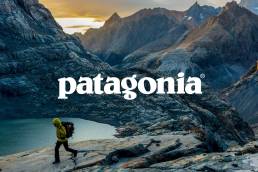
Patagonia’s strategic narrative blends purpose, community, and action to create a brand story that resonates with consumers and drives positive change.
The Strategic Narrative in Action: Patagonia’s Approach
Now that we’ve got the basics down, let’s dive deeper into how Patagonia puts its strategic narrative into action. It’s like watching a magician perform – once you know the tricks, it’s even more impressive!
The “Don’t Buy This Jacket” Campaign
Remember when we said Patagonia sometimes tells people not to buy their stuff? Well, they really did that! In 2011, they ran an ad that said “Don’t Buy This Jacket.” Now, you might be thinking, “That’s crazy! How can a company tell people not to buy their products?” Well, that’s exactly why it worked so well. It got people’s attention and made them think. The ad explained how making the jacket used up resources and caused pollution. It asked people to think hard before buying new things. This campaign showed that Patagonia cared more about the planet than just selling stuff. It was a bold move that fit perfectly with their story of putting the environment first.
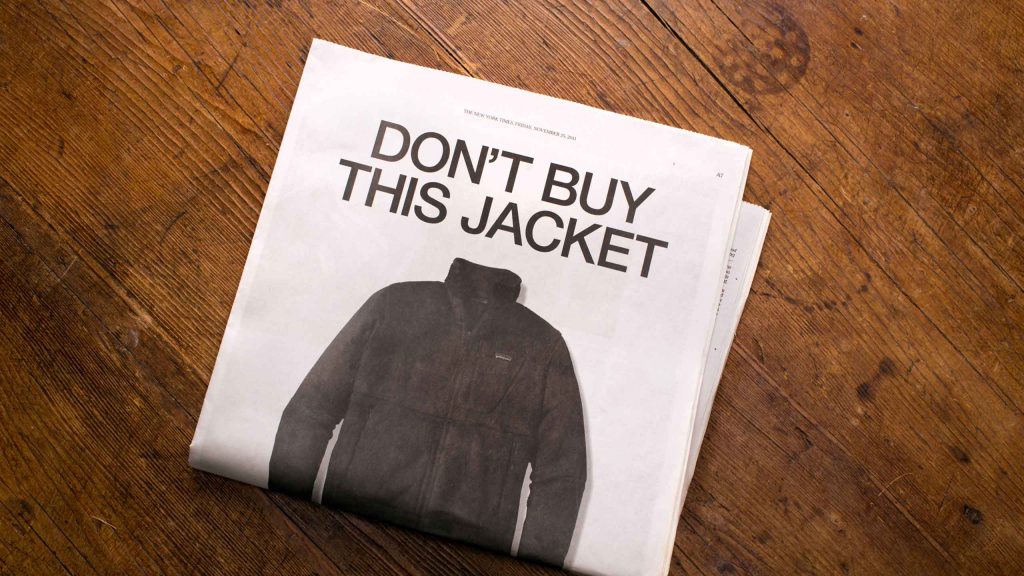
The “Worn Wear” Program
Remember how we talked about fixing old clothes instead of buying new ones? That’s what Patagonia’s “Worn Wear” program is all about. They have special trucks that travel around fixing people’s old Patagonia gear for free. This program tells a powerful part of Patagonia’s story. It says, “We make stuff that lasts, and we’ll help you keep it working.” It’s like having a favorite toy that never wears out because you can always fix it. This program also shows that Patagonia is serious about reducing waste. They’re not just saying, “Buy our stuff because it’s good for the planet.” They’re saying, “Keep using our stuff for as long as you can, because that’s even better for the planet.”
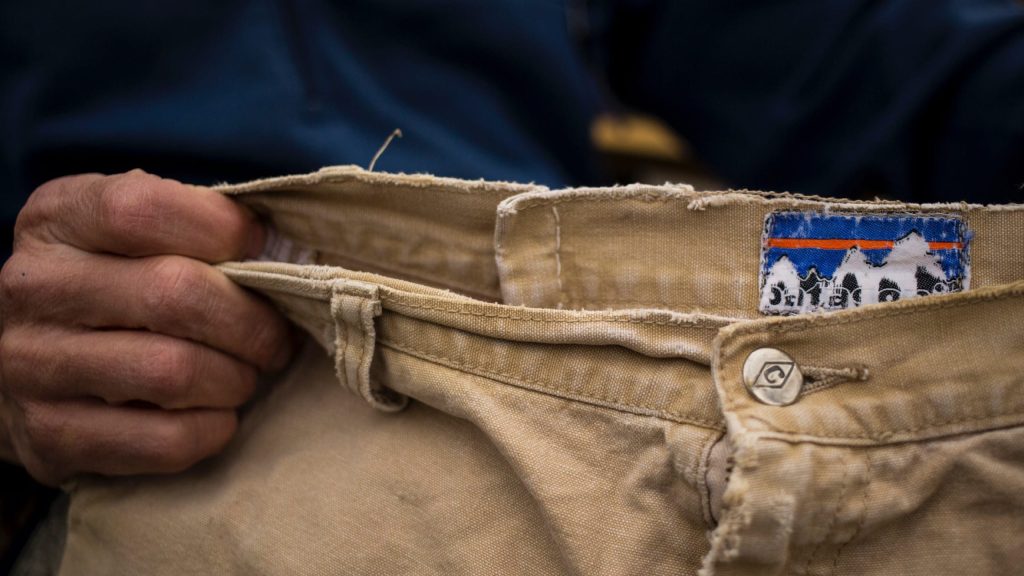
The “1% for the Planet” Pledge
Here’s another cool thing Patagonia does: they give 1% of their sales to environmental groups. That means for every $100 they make, they give $1 to help the planet. It might not sound like much, but it adds up to millions of dollars every year!This pledge is a big part of Patagonia’s story. It shows that they’re willing to put their money where their mouth is. They’re not just talking about helping the environment – they’re actually doing it. And guess what? Patagonia didn’t keep this idea to themselves. They helped start an organization called “1% for the Planet” that encourages other companies to make the same pledge. It’s like starting a club for businesses that want to help the planet!
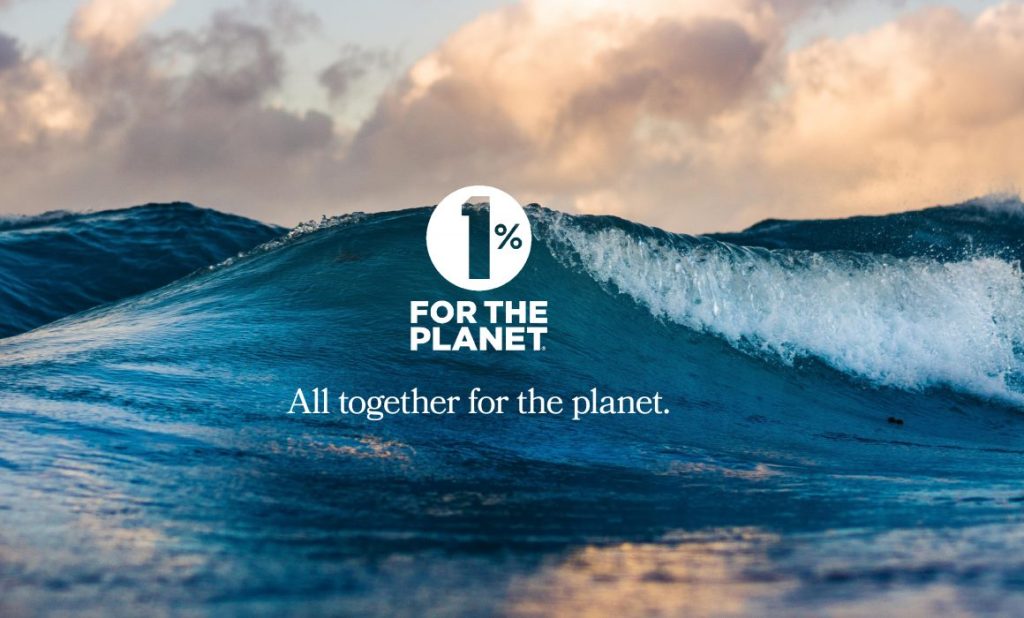
The Power of Visuals: Patagonia’s Imagery
Have you ever noticed how Patagonia’s ads and catalogs are full of beautiful nature photos? That’s not an accident. These images are a big part of how Patagonia tells its story. The photos often show people enjoying outdoor adventures in amazing places. They make you want to go outside and explore. But they also remind you why it’s important to protect these places. Patagonia’s founder, Yvon Chouinard, once said, “We have to make people fall in love with the planet.” These images are one way Patagonia tries to do that. It’s like showing your friend pictures of your favorite place and saying, “See how awesome this is? We need to take care of it!”
Patagonia’s Political Stand
Remember how we said Patagonia isn’t afraid to get political? Well, they really mean it. In 2017, they sued the U.S. government to protect some national monuments. And in 2020, they put tags in some of their clothes that said “Vote the a**holes out.” Now, that’s pretty strong language, and it might have made some people angry. But for Patagonia, it was worth the risk. They believed it was important to stand up for what they believed in, even if it might hurt their business.This is a big part of Patagonia’s story. They’re saying, “We care about these issues so much that we’re willing to risk losing customers over them.” It’s like standing up to a bully on the playground, even if it means you might get in trouble.
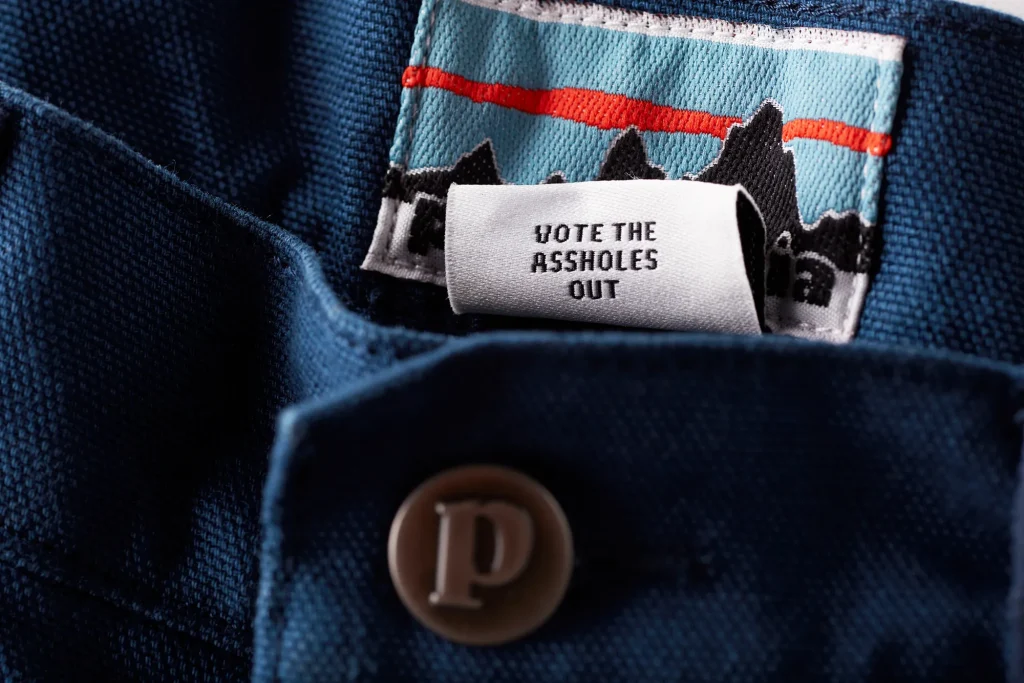
It’s Yvon Chouinard’s comeback to climate-change deniers.
Comparing Patagonia’s Approach to Other Brands
Let’s look at how Patagonia’s story is different from some other outdoor brands:
- The North Face: While The North Face also promotes outdoor adventure, their story focuses more on pushing limits and achieving goals. Patagonia, on the other hand, emphasizes enjoying nature responsibly.
- REI: REI, like Patagonia, promotes environmental stewardship. But REI’s story is more about getting people outdoors, while Patagonia’s story is about protecting the outdoors, even if that means staying home sometimes.
- Nike: Nike tells a story of individual achievement and “Just Do It.” Patagonia’s story is more about collective action and “Let’s protect it.”
The Business Impact of Patagonia’s Strategic Narrative
You might be wondering, “Does all this storytelling actually help Patagonia sell stuff?” The answer is yes! Patagonia has been growing steadily for years. In 2022, they made about $1.5 billion in sales. But remember, for Patagonia, success isn’t just about money. Their story has helped them build a loyal customer base that shares their values. People don’t just buy Patagonia gear; they buy into Patagonia’s mission.This loyalty means Patagonia can charge higher prices for their products. People are willing to pay more because they believe in what Patagonia stands for. It’s like being willing to spend your allowance on a toy you really want, because you know it’s special.
The Future of Patagonia’s Story
In 2022, Patagonia’s founder made a big decision. He gave away the entire company to a trust that will use its profits to fight climate change. This was a huge plot twist in Patagonia’s story!This move shows that Patagonia is committed to its mission for the long haul. It’s like saying, “We’re so serious about saving the planet that we’re giving away our whole company to do it.” This decision has added a new chapter to Patagonia’s story. It’s raised the bar for what it means to be a responsible business. And it’s challenged other companies to think about how they can make a bigger impact.
Lessons for Other Businesses
So, what can other businesses learn from Patagonia’s story? Here are a few key takeaways:
- Be authentic: Patagonia’s story works because it’s real. They don’t just talk about their values; they live them.
- Take risks: Some of Patagonia’s boldest moves, like telling people not to buy their products, have been their most successful.
- Think long-term: Patagonia’s story isn’t about quick profits. It’s about building a sustainable business that can make a difference over time.
- Engage your community: Patagonia doesn’t just tell its own story. It invites its customers to be part of that story.
- Stand for something: Patagonia’s strong stance on environmental issues has set them apart from their competitors.
Wrapping Up: The Power of a Strategic Narrative
Patagonia’s story shows us that a strong strategic narrative can do more than just sell products. It can inspire people, change behaviors, and even help address big global problems. By weaving together their business goals, their environmental mission, and their customers’ values, Patagonia has created a story that resonates deeply with people. It’s a story that makes people want to buy their products, but more importantly, it’s a story that makes people want to be part of something bigger. As we face big challenges like climate change, we need more companies to tell stories like Patagonia’s. Stories that inspire us to think differently, act responsibly, and work together to create a better world. So, the next time you hear a company’s story, ask yourself: Is this just about selling stuff, or is it about something more? Because as Patagonia has shown us, the most powerful stories are the ones that make us want to be better – not just as consumers, but as people
Contact me if you have any questions you’d like answered!
And if you enjoyed this article, be sure to check out my analysis of the strategic narratives of Lego, Nike, Apple, and Harley Davidson.
Related Posts
January 16, 2025
Unraveling Allbirds’ Strategic Narrative
Discover how Allbirds' strategic narrative drives success through…
November 18, 2024
Crafting the Future: OpenAI’s Strategic Narrative
Explore OpenAI's strategic narrative and discover how storytelling shapes its…
November 18, 2024
Unpacking Shopify’s Strategic Narrative: Rewriting the Rules of eCommerce
Explore how Shopify transformed from a snowboard shop to a global commerce…
November 12, 2024
Canva’s Strategic Narrative: How Design Democratization Created a $40 Billion Empire
Discover how Canva's strategic narrative empowers creativity through…
Related Posts
January 16, 2025
Unraveling Allbirds’ Strategic Narrative
Discover how Allbirds' strategic narrative drives success through…
November 18, 2024
Crafting the Future: OpenAI’s Strategic Narrative
Explore OpenAI's strategic narrative and discover how storytelling shapes its…
November 18, 2024
Unpacking Shopify’s Strategic Narrative: Rewriting the Rules of eCommerce
Explore how Shopify transformed from a snowboard shop to a global commerce…
November 12, 2024
Canva’s Strategic Narrative: How Design Democratization Created a $40 Billion Empire
Discover how Canva's strategic narrative empowers creativity through…







